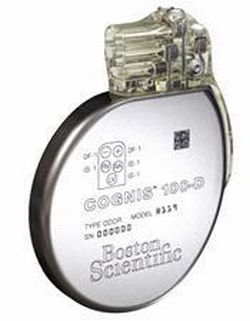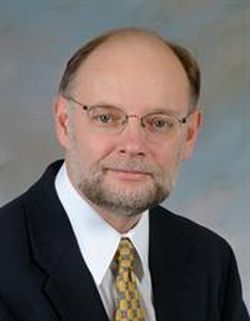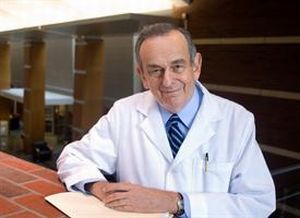Landmark MADIT-CRT Trial Yields More Information on Treatment Benefits in Patients with Mild Heart Failure
Landmark MADIT-CRT Trial Yields More Information on Treatment Benefits in Patients with Mild Heart Failure
Rochester Researchers Present 15 Studies at Premier Cardiology Meeting

- Cardiac resynchronization therapy plus defibrillator
In September 2010, the MADIT-CRT trial led the Food and Drug Administration to approve a treatment known as CRT-D therapy (cardiac resynchronization therapy plus defibrillator) for patients with mild heart disease, signaling a major advance in the treatment of such patients.
But the usefulness of the data didn’t stop there.
Presenting a total of 15 studies at this week’s American College of Cardiology’s Annual Scientific Sessions, researchers from the University of Rochester Medical Center continue to mine valuable information from the milestone trial, furthering our knowledge of heart failure and related disorders, which affect millions worldwide.
Wojciech Zareba, M.D., Ph.D.Led by internationally renowned cardiologists Wojciech Zareba, M.D., Ph.D., and Arthur J. Moss, M.D., fellows and students from the Medical Center conducted the research in collaboration with scientists from across the country and around the world, including Hungary, Italy, Spain, Poland and Israel.
The MADIT-CRT trial, which followed 1,820 patients with mild heart failure for more than four years, is proving to be a treasure chest of valuable data that researchers are drawing on in a quest to find more answers and ultimately provide better care to those living with cardiac disease.

- Wojciech Zareba, M.D., Ph.D.
Arthur J. Moss, M.D.A majority of the group’s latest findings home in on arrhythmias – irregular heart rhythms that are often associated with increased hospitalizations and death – in patients with heart failure. These patients are particularly predisposed to such abnormal rhythms because a damaged heart creates just the right environment for their development.
Researchers are digging deeper to determine the influence of CRT-D therapy on the development of arrhythmias. The therapy combines a defibrillator, designed to prevent sudden, rhythm-related cardiac death, with cardiac resynchronization therapy, designed to improve heart function. New findings include:
>> Improvement in the dyssynchrony – a wobbling heart movement – in patients with heart disease is corrected to a forceful contracting heart movement following implantation of a CRT-D device. Such improvement is associated with a significantly reduced risk of heart failure, irregular heart rhythms and death.
>> In many people with heart failure, the heart is enlarged because it has to work harder than normal to pump blood throughout the body. CRT-D therapy helps reduce the volume of the heart by improving its pumping action. In patients where this occurs, reduction in the volume of atria – the upper chambers of the heart – is associated with a significant reduction in the risk of subsequent atrial tachyarrhythmias, or fast rhythms that occur in the two upper chambers.

- Arthur J. Moss, M.D.
>>CRT-D therapy is associated with a decreased risk of arrhythmias if the lead, or wire that connects the device to the heart, is implanted toward the back or side of the heart.
>> A defibrillator monitors the heart’s electrical activity and responds to irregular rhythms with either anti-tachycardia pacing (ATP) – a quick burst of stimulation to the heart that can correct the arrhythmia process – or shock therapy to prevent sudden cardiac death. In the MADIT-CRT population, patients in whom ATP corrected the arrhythmia had improved outcomes and reduced risk of heart failure or death.
>> In patients with non-ischemic heart disease, a disorder typically characterized by inflammatory scarring of the heart muscle, non-sustained ventricular tachycardia – a fast heartbeat lasting for less than 30 seconds without loss of consciousness or compromise of cardiac function – is associated with an increased risk for dangerous heart rhythm events in the future. These short-lasting rhythm disorders are easily detected and the subsequent dangerous rhythms are effectively terminated with the CRT-D therapy.
“Our findings have a number of clinically relevant implications and provide greater insight into the type of patients who will receive the greatest benefit from CRT-D therapy,” said Zareba,director of the Heart Research Follow-up Program at the Medical Center. “The more we understand the favorable effects of the therapy, the better we can select at-risk cardiac patients for preventive therapy.”
“These findings from the international MADIT-CRT trial provide further evidence of the strong clinical benefit that is achieved with cardiac resynchronization therapy in adult patients with common forms of heart disease,” said Moss, principal investigator of the MADIT-CRT trial, which was sponsored exclusively by Boston Scientific.
Authors of the studies presented this week at the scientific sessions include Andrew Brenyo, M.D., Alon Barsheshet, M.D., Mohan Rao, M.D., Justin Penn, M.D., Scott McNitt, M.S., Ilan Goldenberg, M.D., Wojciech Zareba, M.D., Ph.D., and Arthur J. Moss, M.D. from the University of Rochester Medical Center, Rochester, NY; Anne-Catherine Pouleur, M.D., Dorit Knappe, M.D., Ph.D., and Scott Solomon, M.D. from the Brigham and Women’s Hospital, Boston, MA; Suneet Mittal, M.D., St. Lukes-Roosevelt Hospital, New York; Valentina Kutyifa, M.D., Hungary; Michal Gibinski, M.D., Poland; Yonatan Buber, M.D., Israel; and Luigi Padeletti, M.D., Italy.
* For Media Inquiries: Emily Boynton 585-273-1757
** The above story is reprinted from materials provided by University of Rochester Medical Center




















